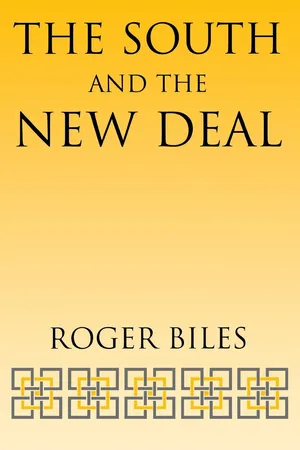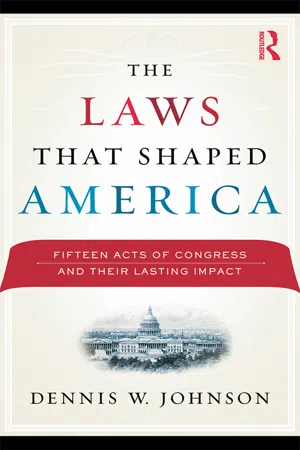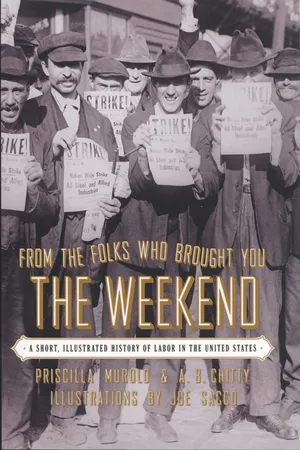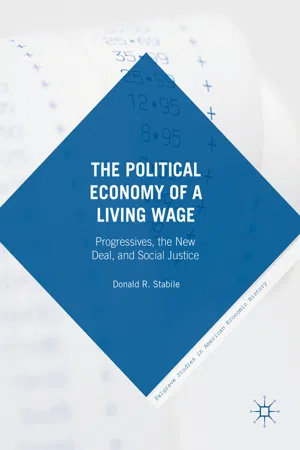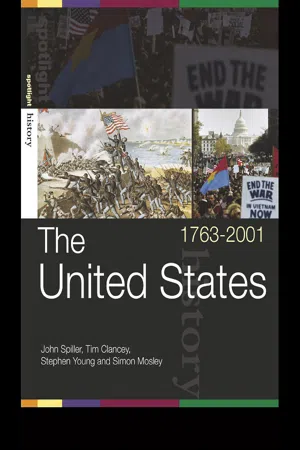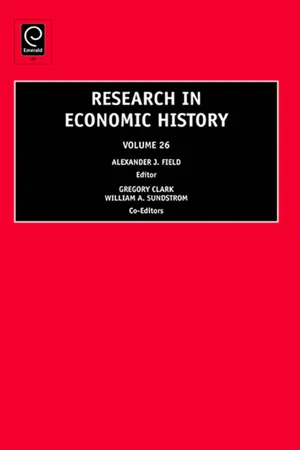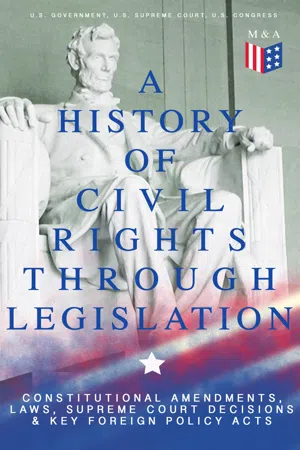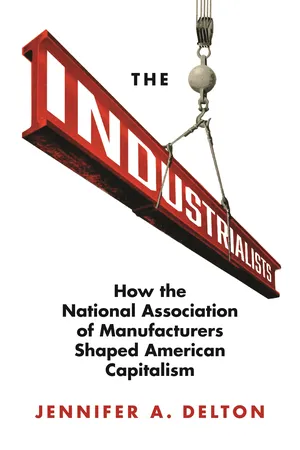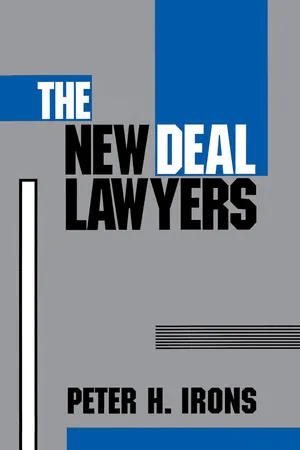History
National Industrial Recovery Act
The National Industrial Recovery Act (NIRA) was a US law enacted in 1933 during the Great Depression. It aimed to stimulate economic recovery by establishing codes of fair competition for industries, promoting industrial growth, and encouraging collective bargaining. The NIRA also created the Public Works Administration to provide employment through infrastructure projects. However, it faced constitutional challenges and was ultimately declared unconstitutional in 1935.
Written by Perlego with AI-assistance
Related key terms
1 of 5
12 Key excerpts on "National Industrial Recovery Act"
- eBook - PDF
Rugged Justice
The Ninth Circuit Court of Appeals and the American West, 1891-1941
- David C. Frederick(Author)
- 2023(Publication Date)
- University of California Press(Publisher)
As cases arising under the National Industrial Recovery Act demonstrated, even judges sympathetic to the Roosevelt administration sometimes disagreed sharply among themselves. III. JUDICIAL CHASMS OVER RECOVERY LEGISLATION Democrats generally viewed the National Industrial Recovery Act (NIRA) as the legislative centerpiece of Roosevelt's first hundred days. Like the many New Deal agricultural reform efforts, this program gave statutory expression to a popular assumption that the market system had failed. Government action, New Dealers contended, would restore proper returns for businesses and ensure reasonable wages for workers. The NIRA accordingly required the establishment of codes of fair com- petition and minimum wages for workers. Principally through these two mechanisms, but also through other measures, the Roosevelt ad- ministration hoped to achieve several ambitious goals: to put idle plants back into operation, to boost employment by decreasing working Adjudicating the New Deal 199 hours, and to create equitable pricing. The statute attempted to balance the interests of labor, business, and consumers. The Democrats believed that industry and labor would abstain from unfair competition if they were permitted to establish mutually agreeable rules governing compe- tition. This program received an immediate legal challenge, and com- mentators attacked the plan as "naive advice" to business: "Congress realizes that it has not found the key to recovery, and it abdicates in favor of business. The Act which it has adopted and which has since been put forward, with the fanfare of trumpets, synthetic war psychol- ogy, and extravagant advertising, as the National Industrial Recovery Act is a comprehensive blank." 23 Congress delegated to the private sector the authority to fill in this blank through the establishment of local codes of fair competition, a deputation found unconstitutional by the Supreme Court in the land- mark case of A.L.A. - eBook - ePub
Deconstructing the Monolith
The Microeconomics of the National Industrial Recovery Act
- Jason E. Taylor(Author)
- 2019(Publication Date)
- University of Chicago Press(Publisher)
2 The Underpinnings, Precursors, and Development of the NIRA The National Industrial Recovery Act was passed on June 16, 1933. The Act was a fitting bookend to President Franklin D. Roosevelt’s first hundred days of major reforms to the US regulatory system (see Alter 2006; Badger 2008; Cohen 2009). In a statement announcing the NIRA’s passage, Roosevelt predicted that history would view it “as the most important and far-reaching legislation ever enacted by the American Congress.” This statement appears not to be hyperbole when one considers just what economic changes the Act brought. The NIRA created the Federal Emergency Administration of Public Works (later renamed the Public Works Administration) and authorized $3.3 billion toward public works projects. The Act boosted hourly wage rates, cut workweeks, and required industry to recognize the right of collective bargaining. The Act suspended antitrust laws and facilitated intraindustry collusion. The logic behind the creation of an agency providing funding for public works during a time of high unemployment is clear. But why did the Roosevelt administration think a policy of cartels, high wages, and reduced work hours would promote recovery from the Great Depression? 1 This question invariably comes up when NIRA scholars discuss the program in classrooms, conferences, and seminars. After all, economic theory suggests that cartels reduce, not expand, output (and hence employment) since the profit-maximizing monopoly output is below the perfectly competitive one. Furthermore, with unemployment already exceeding 20 percent in the spring of 1933, wage rates were clearly above, not below, their market-clearing level - eBook - PDF
- Roger Biles(Author)
- 2014(Publication Date)
- The University Press of Kentucky(Publisher)
Change came only after fierce resistance and was often not evident until years later. Yet if not for the intrusion of New Deal agencies, these breakthroughs would have been even more delayed. 1 RELIEF AND EMPLOYMENT 59 As the Hundred Days of feverish legislative activity unfolded, the uncertainty of Roosevelt's obscure and often contradictory campaign rhetoric gave way to concrete legislation. The president's programs designed to stimulate economic recovery generated con-siderable comment, none more so than the pathbreaking National Industrial Recovery Act (NIRA). Passed by Congress as an alterna-tive to Alabama senator Hugo L. Black's bill, which reduced work weeks in all industries to thirty hours, the NIRA sought to stabilize business with codes of fair competitive practice. In each major in-dustry, representatives of management, labor, and government drafted codes regulating production, wages, and working conditions. Patterned after the trade-association movement favored by Herbert Hoover, the NIRA went beyond the former president's concept of voluntarism by authorizing the National Recovery Administration (NRA) to establish legal compliance standards for those companies that elected to participate. 2 NRA chief Hugh S. Johnson enlisted existing trade associations to initiate the program, and with the cooperation of the Cotton Tex-tile Institute, the textile industry completed the first code of fair practice. The new agreement brought standard hours for industry workers down from fifty or fifty-five to forty, set minimum weekly wages of twelve dollars in the South, eliminated child labor in the mills, prohibited plant operations for more than eighty hours per week, and adopted the NIRA's section 7(a), which guaranteed labor the right to collective bargaining. Overproduction of textiles had glutted markets for years, and the industry's severe economic prob-lems accounted for its willingness to embrace the NRA's formula for industrial cooperation. - eBook - ePub
The Laws That Shaped America
Fifteen Acts of Congress and Their Lasting Impact
- Dennis W. Johnson(Author)
- 2009(Publication Date)
- Routledge(Publisher)
53In the House, the NIRA easily passed, with minor changes but then ran up against stiff opposition in the Senate from progressives, particularly William E. Borah (Republican–Idaho), who warned that, with the suspension of antitrust provisions, big business would dominate the code-making process. But the administration prevailed, the Senate beat back Borah’s objections, and the NIRA became law on June 16, 1933.54 At the signing ceremony, Roosevelt promised that the NIRA would put millions back to work that summer, permitting them to buy goods and services, and get the economy going again. Despite the fact that he was not really fully engaged in the legislation, Roosevelt remarked to the newsmen at the signing ceremony that “history will probably record the NIRA as the most important and far-reaching legislation ever enacted by the American Congress.”55 Senator Wagner, who certainly was engaged, was equally confident, saying that he felt that the “greatest victory in my war against human misery had been achieved.”56 But there were many policymakers and critics who had their doubts; not the least of those doubters was Justice Louis D. Brandeis.The NIRA called for the creation of the National Recovery Administration (NRA) to oversee the creation of industry codes and a National Labor Board (NLB) to settle disputes. The NRA devised the Blue Eagle public relations campaign: businesses large and small pledged to comply with the NRA program, display the Blue Eagle sign or flag on their premises, and proclaim, “We Do Our Part.” Codes would be developed for each industry, which would promise to produce higher wages, lower working hours, and better labor conditions. In exchange, industries would be exempted from antitrust regulations. Over two million employers enlisted.57 - No longer available |Learn more
From the Folks Who Brought You the Weekend
An Illustrated History of Labor in the United States
- Priscilla Murolo, A.B. Chitty, Joe Sacco(Authors)
- 2018(Publication Date)
- The New Press(Publisher)
The federal government suspended antitrust laws and called on business leaders in major industries like steel, auto, textiles, and mining to draw up “codes of fair competition,” which the president then signed into law. 1 Smaller industries soon followed suit, extending NIRA codes to 90 percent of the nonagricultural economy. The codes regulated prices, production quotas, product standards, and labor conditions. A new federal agency, the National Recovery Administration (NRA), administered the program and touted it far and wide with parades, rallies, placards, and songs. The NRA’s Blue Eagle insignia adorned goods marketed by companies in compliance with the program, providing a seal of approval for patriotic shoppers. Noncompliant companies could be prosecuted, but the government seldom pressed charges. It relied instead on negotiation and persuasion, seeking what Roosevelt called a “partnership in planning” with business. 2 Workers, on the other hand, would have to fight to be heard. At the government’s insistence, businessmen adopted industrial codes that banned child labor and established both minimum wages and maximum hours—typically a forty-hour workweek for at least $12 to $15. This certainly improved conditions in many workplaces, but in the absence of unions, employers hired and fired at will, sped up the pace of work, and kept wage scales close to the new minimums. The New Deal’s main concession to workplace democracy was NIRA Section 7(a), which declared that workers “shall have the right to organize and bargain collectively through representatives of their own choosing, and shall be free from the interference, restraint, or coercion of employers of labor, or their agents.” 3 But it soon became apparent that corporate executives did not intend to obey this part of the law and that Washington would not force the issue. The New Deal showed time and again that a federal declaration of labor rights was merely a piece of paper - eBook - ePub
The Political Economy of a Living Wage
Progressives, the New Deal, and Social Justice
- Donald Stabile(Author)
- 2016(Publication Date)
- Palgrave Macmillan(Publisher)
52Workers needed a living wage to keep the society from having to provide some or all of their needs and unions were the way for them to get a living wage is what Green was saying here.This focus on the cooperative activity to be brought about by the NIRA did not distract the AFL from remembering the primary need in the economy—increased purchasing power for labor. In yet another article in the June issue of the American Federationist , “Recovery Program,” the writer outlined many of the early New Deal policies, such as going off the gold standard, that were reducing consumption. The NIRA would be different because with it Roosevelt took on “the fundamental obstruction which is holding business down—shortage of buying power.” Here, as before, the argument was that most businesses wanted “to maintain wages.” But a few “selfish employers” cut wages in order to undersell those businesses. The NIRA would curb these unfair employers and take a big step “toward the maintenance of fair wages.” The result would be a better balance “between producing and buying power.”53The AFL was in accord with Roosevelt’s goal for the NIRA of a living wage for workers. In its next issue, the American Federationist published Roosevelt’s statement on the NIRA, including its call for living wages, under the title, “An Industrial Covenant.”54It followed up with another article, “Recovery—Facts for Code Making,” which reminded readers and those writing industry codes, “The two chief objectives in a campaign to restore buying power are: Put men to work and raise their wages.” Both objectives should be a part of the industry codes. As to the question of how high the wages should be raised, the American Federationist answered that they should be at least “a living wage” as defined by budget studies.55Green repeated this notion in the August 1933 issue of the American Federationist by writing about his desired outcome of code making, “One of our first considerations in fixing wages is to give the worker a living wage. The President left no doubt about this in his statement of policy on signing the Recovery Act on June 16.”56 - eBook - ePub
- Tim Clancey, Simon Mosley, John Spiller, Stephen Young(Authors)
- 2004(Publication Date)
- Routledge(Publisher)
The part of NIRA that is most often focused upon is Section 7(a), which allowed workers to freely organise into unions. Radical critics of the New Deal claim that Section 7(a) was also a concession to labour in return for the acceptance of the codes of conduct that allowed business to regulate itself. Furthermore, it was conceptualised as being in the long-term interests of business anyway. Unionisation was a way for business to institutionalise their conflict with labour within the existing corporate system, thus forestalling the development of any more serious opposition. In 1926 the leading moderate, Gerard Swope, had tried to convince other industrialists of the need for unionisation, explaining that the outcome would be ‘the difference between an organisation with which we could work on a businesslike basis and one that would be a source of endless difficulties’ (Radosh).However this can be seen as an overly cynical view of the NRA and its codes. The historian Anthony Badger has written that the impetus for business self-regulation came from smaller companies who stood to gain more than big business through the reduction in competition. Some labour leaders too had been supportive of such measures, seeing the destructive effects of competition as a danger to jobs within their industries. The inspiration behind Section 7(a) had actually come from the United Mine Workers, which had proposed the acceptance of codes of self-regulation in their industry in return for guaranteed rights of collective bargaining (Badger). The apportionment of influence behind the legislation can be debated but it is undisputable that the aim of NIRA was to promote economic recovery.(b) The National Recovery Administration Act was vast in its scope, incorporating hastily drawn up codes of conduct for many different industries and $3.3 billion of funding for a Public Works Administration. The aim was to promote industrial recovery. There were differing views about the best way to achieve this goal and so it is no surprise to find that the Act provoked criticism. The most contentious opposition came from small businesses, larger industries and organised labour. This central piece of the First New Deal, which had attempted to please all, ended up pleasing no one during its two-year lifespan.Many small firms felt aggrieved that the process of writing the codes of conduct was dominated by big business. Government officials commonly left industries to draw up the codes themselves due to a lack of knowledge and time. The resulting codes did not significantly aid economic recovery but it was felt they had resulted in tilting the playing field even more in the favour of big business. Codes covering restrictions on levels of production together with the overlooking of anti-trust measures were a licence for larger corporations to operate the NRA to their own advantage at the expense of smaller companies, which were squeezed out (Badger). Opposition also came from several senators who supported the position of the small businessman. They were against the suspension of anti-trust legislation and wished to see the full restoration of market conditions. - eBook - PDF
- Alexander J. Field, Gregory Clark, William A. Sundstrom, Alexander J. Field, Gregory Clark, William A. Sundstrom(Authors)
- 2008(Publication Date)
- Emerald Group Publishing Limited(Publisher)
However, as it became apparent to firms that government punishment was unlikely, the few initial unpunished defections begat further defections, which soon became a title wave of defections so large that even a few scattered incidences of belated government enforcement could not stop. The broader implications of the study are relevant not just to formal, state-enforced cartels, but also to regulatory and other policies that facilitate collusion (e.g., Rothbard, 1984 ). THE LOGIC OF THE NIRA The NIRA was passed by Congress June 16, 1933. Supporters claimed that inter-firm coordination would promote industrial recovery by ending the ‘‘ruinous’’ or ‘‘cut-throat’’ competition widely seen as the cause of the Depression. Industry cooperation was viewed as having been largely successful during World War I and was subsequently portrayed as the best hope for recovery. Donald Richberg, General Council of the National Recovery Administration (NRA), the NIRA’s enabling body, explained that ‘‘individual self-protection must give way to an orderly common effort’’ and ‘‘that thousands of businessmen themselves should know better than any small group of lawmakers’’ what specific collective efforts would best stimulate economic recovery ( Irons, 1982, p. 97 ). Following this logic, manufacturing industries were required under the Act to write codes of fair competition, subject to some governmental oversight, specifying detailed rules, and regulations for firm behavior. The NIRA established 765 industry and supplemental codes, each containing several trade-practice provisions. The most common provision – contained in over 400 codes, including those for the pig iron, steel, coal, newsprint, lead, and woodworking machinery industries – was open price filing, which required firms to file their prices with code authorities and give advance notice of any price changes. As is well known in the modern Anatomy of a Cartel 237 - eBook - PDF
The Bureaucrat Kings
The Origins and Underpinnings of America's Bureaucratic State
- Paul D. Moreno(Author)
- 2016(Publication Date)
- Praeger(Publisher)
Such agreements would be exempt from the antitrust laws. Essentially, the NIRA invited businessmen to establish “cartels,” or agreements not to compete. 4 Every code had to guarantee collective bargaining for organized labor, so that labor cartels (unions) could balance employer cartels. Employers got around this guarantee by recognizing their own employee representation plans or “company unions.” If an industry could not devise an acceptable code, then the president could impose one, and could require that businesses obtain licenses to operate. The act would be enforced by the National Recovery Administration (NRA). The NIRA’s farm equivalent—the Agricultural Adjustment Act (AAA)— similarly tried to cartelize American agriculture, getting farmers to agree to limit production to raise prices. If prices did not rise enough, then farmers would receive a subsidy from a tax on farm product processers. States also promoted industrial and agricultural cartels in their “little New Deals.” The NIRA often was likened to Prohibition—impossible to enforce in such a vast and diverse nation without establishing a police state. The sheer number and complexity of American industries was baffling. Codes were written for the Powder Puff Industry, the Academic Costume Industry, the “Industry Engaged in the Smelting and Refining of Secondary 86 The Bureaucrat Kings Metals into Brass and Bronze Alloys in Ingot Form,” and the “Fluted Cup, Pan Liner, and Lace Paper Industry.” The code for the Burlesque Theatrical Industry said, By reason of the peculiar nature of this Industry, it is impracticable without further data, to be furnished by the Code Authority, to set the maximum hours for actors and chorus. Therefore, the Code Authority shall investigate the hours of labor, wages, and working conditions of actors and chorus, and . . . - eBook - ePub
- U.S. Government, U.S. Supreme Court, U.S. Congress(Authors)
- 2017(Publication Date)
- Madison & Adams Press(Publisher)
National Industrial Recovery Act
(1933)Table of ContentsACTTITLE I – Industrial RecoveryTITLE II – Public Works and Construction ProjectsTITLE III – Amendments to Emergency Relief and Construction Act and Miscellaneous ProvisionsPassage contains an image
ACT
Table of ContentsTo encourage national industrial recovery, to foster fair competition, and to provide for the construction of certain useful public works, and for other purposes. Be it enacted by the Senate and House of Representatives of the United States of America in Congress assembled,Passage contains an image
TITLE I: Industrial Recovery
Table of ContentsDECLARATION OF POLICYSec. 1.A national emergency productive of widespread unemployment and disorganization of industry, which burdens interstate and foreign commerce, affects the public welfare, and undermines the standards of living of the American people, is hereby declared to exist. It is hereby declared to be the policy of Congress to remove obstructions to the free flow of interstate and foreign commerce which tend to diminish the amount thereof; and to provide for the general welfare by promoting the organization of industry for the purpose of cooperative action among trade groups, to induce and maintain united action of labor and management under adequate governmental sanctions and supervision, to eliminate unfair competitive practices, to promote the fullest possible utilization of the present productive capacity of industries, to avoid undue restriction of production (except as may be temporarily required), to increase the consumption of Industrial and agricultural products by increasing purchasing power, to reduce and relieve unemployment, to improve standards of labor, and otherwise to rehabilitate industry and to conserve natural resources.ADMINISTRATIVE AGENCIESSec. 2. - eBook - ePub
The Industrialists
How the National Association of Manufacturers Shaped American Capitalism
- Jennifer A. Delton, Jennifer Delton(Authors)
- 2020(Publication Date)
- Princeton University Press(Publisher)
35 The federal government could also cultivate international trade, possibly with loans. NAM did not blink an eye at any of these progressive departures from “time-tested” ideas of free market competition and individualism. In fact, it worked closely with Hoover to promote this agenda.The Roosevelt administration continued the general direction of Hoover’s economic policies—but on steroids and with a noxious prolabor union bent.36 The New Deal’s economic centerpiece was the National Industrial Recovery Act (NIRA), which had the stated purpose of promoting “the organization of industry for the purpose of cooperative action among trade groups.”37 Once organized, these organizations would devise codes of fair competition, which would set standard wages, hours, and a method to ensure the compliance of the entire industry so that nonconformists did not profit from undercutting the standard. This was essentially the codification of Hoover’s voluntary program of systematizing and regulating industries.The NIRA wasn’t simply about propping up trade associations, however. In the eyes of many, it was a license to monopoly. Many of these trade associations had spent the 1920s trying to evade antitrust laws and to stabilize prices by agreeing to restrict output.38 Although NAM itself was not the kind of industry-specific trade association that would benefit from ending antitrust laws, many of its members expected NAM to take a strong anti-antitrust position, which it did. The Depression confirmed to many the dangers of overproduction and hence the need for planning, which in practice would mean output restriction. Indeed, the aim of the NRA and its partner, the Agricultural Adjustment Administration (AAA), was to restrict production to raise prices, which would allow companies to start hiring again.39 - eBook - ePub
- Peter H. Irons(Author)
- 2020(Publication Date)
- Princeton University Press(Publisher)
They attempted at considerable length to distinguish the “hot oil” cases on the ground that, as opposed to Section 9(c), the code-making powers conferred upon the President by Section 3 rested on the “intelligible standards’’ set out in the Act’s Declaration of Policy. The final Schechter brief summarized the issue in these terms: “The delegation will be found justified by the unprecedented economic chaos existing in the spring of 1933, which compelled Congress to provide for the regulation of a subject of magnitude requiring great flexibility in dealing with different conditions and diverse elements in the various industries. . . . When Congress convened, the banks were closed, millions were unemployed, and business was stagnant. The nation was at the verge of panic; hope and confidence was based largely upon the belief that Congress would take immediate action. ... It was believed that the distress of industry was largely due to the excess of competition, to competitive practices which had caused overproduction, lower and lower prices, wage cutting and unemployment. The Recovery Act was an attempt to combat these evils.’’ 19 The final product of the drafting session was a 175-page brief delivered to the Supreme Court clerk’s office on May 1, the day before oral argument was scheduled. Its internal structure reflected the inherent tension between the dual elements of the NIRA’s corporatist approach to recovery. On one hand, the brief stressed the economic nationalism of Robert Stern’s commerce clause interpretation; on the other, it relegated the administration of this nationalist scheme to the very corporate interests supposedly regulated by it. Corporatist ideology saw no contradiction in this structure
Index pages curate the most relevant extracts from our library of academic textbooks. They’ve been created using an in-house natural language model (NLM), each adding context and meaning to key research topics.


